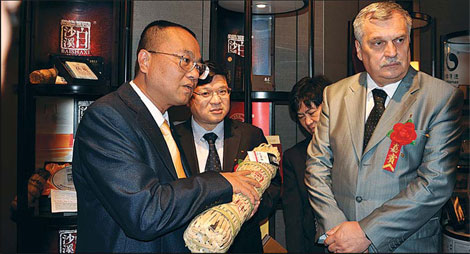14
2011/06
分享
Hunan Special: Thirst growing for Hunan's fermented dark tea
发布时间:
2011-06-14 12:00
来源:
chinadaily
Hunan Special: Thirst growing for Hunan's fermented dark tea
By Tian Yang (China Daily)
|
Liu Xin'an (left), general manager of Baishaxi Tea Industry Co Ltd, presents dark tea to a Romanian official. Provided To China Daily
|
The dark tea popular in China's western region during the Ming Dynasty (1368-1644) is now enjoying a revival in both domestic and overseas markets.
Not as widely known as many other varieties - and often mistaken for black tea - dark tea is named for leaves that blacken after special treatment. It only grows in China, with about 60 percent of it produced in the central province of Hunan.
Yet Hunan residents themselves don't usually drink it. Instead, the tea is popular in remote, border areas that are home to ethnic groups.
Their preference is due to the belief that dark tea can offset surplus fat in a diet of mostly meat and milk.
It is also known as brick tea due to the compressed shape merchants used for easier transport over long distances.
Dark tea was discovered by accident, according to Chinadarktea.com. When shipped north on the sea and then along the Silk Road in ancient times, humid air caused dried leaves to ferment and develop a strong aroma. The change also gave the tea greater longevity.
Today the tea is processed differently than other varieties to replicate the flavor.
Tea leaves are heated, kneaded and twisted, then sprinkled with water and placed in huge piles under cloth to ferment before being dried.
After treatment, the tea takes on a dark black color. Once brewed, it has a strong aroma with a thick flavor. The taste and aroma are said to improve with age.
But compared to Longjing, Hunan's dark tea is not well known - a situation local tea makers expect to change.
Baishaxi Tea Industry Co Ltd, based in the birthplace of dark tea in Anhua county of Hunan province, is one of the major producers. Established in 1939, the company has created various kinds of dark tea.
Together with other Hunan tea companies, Baishaxi started a tour earlier this month to promote dark tea in Europe. Destinations included Hungry, the Czech Republic, Romania, Turkey, the Ukraine and Russia.
At the third stop of the tour in Bucharest, Romanian government officials and local red wine makers gathered to appreciate dark tea from Hunan. A precious type named Qianliang caught their attention.
Qian in the name means one thousand and liang refers to China's old measurement of weight - about 32 liang to a kilogram. The tea got its name because it is shaped in rolls that each weigh about 1,000 liang.
The secret recipe for Qianliang used to belong to a family in Anhua. It was later hand-made exclusively by Baishaxi in the 1950s and sold according to a government distribution plan. In 1958 the company began mechanized production and stopped making Qianliang.
In the late 1990s, Baishaxi resumed production of Qianliang to meet demands from overseas enthusiasts. The tea is now mainly sold in Southeast Asia, Guangdong, Hong Kong and Taiwan.
Today, Baishaxi's plantation covers more than 4 million square meters. Its two production lines have combined capacity to produce 5,000 tons of dark tea each year.
In 2010, its dark tea was selected among China's 10 most famous teas and displayed in the United Nation Pavilion at the Shanghai World Expo.
As a distinct symbol of Hunan's traditional culture and craftsmanship, it is now one of the most favored presents from local residents to friends at home and abroad.
(China Daily 05/31/2011 page15)
湖南特产:快速增长的湖南黑茶
中国日报:田杨(音译)

湖南省白沙溪茶厂有限责任公司总经理刘新安(左)向罗马尼亚官员赠送黑茶(百两茶)
自明朝(1368-1644)以来,(湖南)黑茶流行于我国西部少数民族地区,现在(湖南)黑茶开始在国内外市场复苏。
(在我国的六大茶类之中)黑茶并不像其他茶类那么受人所知,而且常与红茶相混淆。黑茶的得名在于其特殊的加工工艺使其干茶色泽黑褐油润,黑茶只有中国有,全国60%的黑茶都产于湖南的中部地区。
然而湖南当地的居民喝黑茶的并不多,(长期以来)黑茶流行于我国的广大少数民族地区。由于黑茶能够有效的化解饮食中从肉食(牛肉)和奶制品摄取的过多脂肪,西北人民特别偏爱黑茶。
众所周知,黑茶由于其紧压成砖形,便于商人长距离的运输。
通过中国黑茶网(www.chinadarktea.com),我们了解到,黑茶的诞生源于一次意外:在古代,人们先通过船运,然后走丝绸之路将茶叶运到我国北方地区和其他国家,潮湿的天气使干茶发酵(茶叶被雨水淋湿)并产生一种强烈的香气。这种变化(发酵过程)延长了黑茶的“寿命”(使黑茶能够长期存放)。
如今,黑茶因为其独特的香味与其他茶类区别开来。在干燥以前,茶叶要经过杀青、揉捻、渥堆(在干茶上撒水,然后摊放在地面上,用一层布料覆盖)。
在经过上述加工之后,茶叶变得黑褐油润。经过发酵的黑茶,具有浓烈的香气和厚重的口感,这种香气和口感将会随着年份的增加而增强。“与西湖龙井相比,湖南黑茶并不广为人知,这种情况将会改变”湖南黑茶的生产企业预料。
湖南省白沙溪茶厂有限责任公司是一家大型黑茶生产厂家,是紧压茶的摇篮,位于湖南安化,该厂创办于1939年,大量黑茶系列产品诞生于白沙溪茶厂。
和其他湖南黑茶厂家一道,白沙溪于本月(5月)早些时候开始了黑茶的欧洲之旅。包括匈牙利、捷克共和国、罗马利亚、土耳其、乌克兰和俄罗斯。
在(湖南黑茶欧洲之旅的)第三站:布加勒斯特(罗马尼亚首都),罗马利亚官员与当地红酒生产商齐聚一堂感悟来自湖南的黑茶。神秘的千两茶吸引了很多人的目光。
千两茶的因其外形和重量得名,其重为一千两(按中国老秤计算重量:32两为一公斤)。
这款神秘的千两茶制作工艺一直以来被安化(刘姓)家庭掌握。五十年代以后千两茶手工加工工艺被白沙溪传承,通过国家计划销售。1958年,白沙溪在千两茶加工工工艺的基础上研制出了新的产品(花砖茶),使其机器化生产。
在九十年代末期(1997年),为了应合海外市场的需求,白沙溪恢复了千两茶的生产,畅销于东南亚、广东、香港、台湾等地。
现在白沙溪拥有超过四百万平方米的茶园基地,其两条现代化的机器生产线每年能够生产5000吨的黑茶成品。
在2010年,湖南黑茶入选“中国世博十大名茶”,在2010年上海世博会联合国馆展示。
作为能够代表湖南传统风俗文化和工艺的产品,湖南黑茶日益成为国内外朋友礼尚往来的交流载体。
(注:本文译文仅供参考,略有改动)
译者:孟涛
(中国日报 2011年5月31日 第15页)


